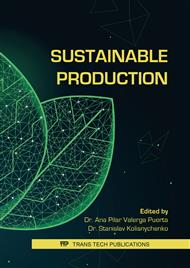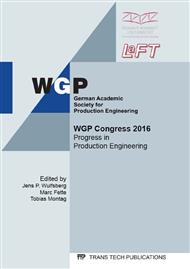[1]
Y. Atsmon, P. Child, R. Dobbs and L. Narasimhan, Winning the $30 trillion decathlon: Going for gold in emerging markets, in: McKinsey Quarterly, August 2012, last accessed on 21-03-2016. available at: http: /www. mckinsey. com/business-functions/strategy-and-corporate-finance/our-insights/winning-the-30-trillion-decathlon-going-for-gold-in-emerging-markets.
Google Scholar
[2]
T. Bauernhansl, Energieeffizienz in Deutschland – eine Metastudie, Berlin, Heidelberg: Springer-Verlag, (2014).
Google Scholar
[3]
W. McDonough, M. Braungart, Cradle to cradle. Remaking the way we make things. 1st ed. New York: North Point Press, (2002).
DOI: 10.1017/s1466046609990494
Google Scholar
[4]
J. Lentes, J. Mandel, U. Schliessmann, Competitive and sustainable manufacturing by means of ultra-efficient factories in urban surroundings, in: CIRP proceedings 23rd International Conference on Production Research, (2015).
DOI: 10.1080/00207543.2016.1189106
Google Scholar
[5]
N.N., Die energieeffiziente Modellfabrik der Zukunft, http: /www. eta-fabrik. tu-darmstadt. de/eta/index. de. jsp, last accessed on 06-07-(2016).
Google Scholar
[6]
N.N., E³-Forschungsfabrik Ressourceneffiziente Produktion, http: /www. e3-fabrik. de, last accessed on 06-07-(2016).
Google Scholar
[7]
K. Erlach, Value stream design: The way towards a lean factory, 2. Aufl. Berlin, Heidelberg: Springer-Verlag (VDI-Buch). (2010).
Google Scholar
[8]
K. Erlach, D. Köhler, M. Süchting, T. Schrodi, T. Kuhlmann, CO2-Wertstrom: Integrierte ökologische und ökonomische Bewertung und Optimierung, in: wt Werkstattstechnik online 102 (2012), Nr. 7-8.
DOI: 10.37544/1436-4980-2012-7-8-518
Google Scholar
[9]
M. Dörr, S. Wahren, T. Bauernhansl, Methodology for energy efficiency on process level, in: Procedia CIRP 7, 652 – 657, (2013).
DOI: 10.1016/j.procir.2013.06.048
Google Scholar
[10]
A. Sauer, Energieorientierte Unternehmensführung durch Energiemanagmentsysteme (EMS)?, in: Industrie Management 5/2013, S. 53-57.
Google Scholar
[11]
T. Bauernhansl, J. Mandel, S. Diermann, Evaluating Changeability Corridors for Sustainable Business Resilience, in: Procedia CIRP 3, 364 – 369, (2012).
DOI: 10.1016/j.procir.2012.07.063
Google Scholar
[12]
T. Kuhlmann, T. Bauernhansl, Method for Designing an Energy-agile Energy System for Industrial Manufacturing, in: Procedia CIRP 29, 179–184, (2015).
DOI: 10.1016/j.procir.2015.02.005
Google Scholar
[13]
T. Kuhlmann, A. Sauer, Bewertung von Ultraeffizienzmaßnahmen - Skalierbarer, ganzheitlicher Ansatz zur Bewertung von Ultraeffizienzmaßnahmen in der Produktion, in: wt Werkstattstechnik online 106, Nr. 1-2, (2016).
DOI: 10.37544/1436-4980-2016-01-02-85
Google Scholar



